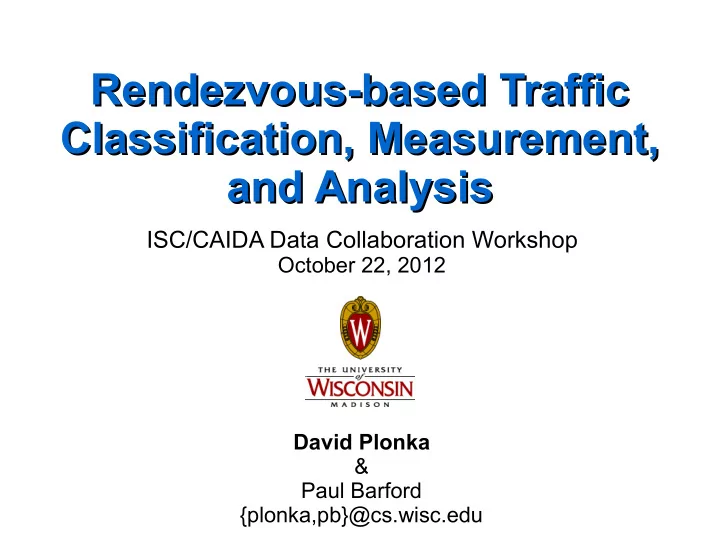

Rendezvous-based Traffic Rendezvous-based Traffic Classification, Measurement, Classification, Measurement, and Analysis and Analysis ISC/CAIDA Data Collaboration Workshop October 22, 2012 David Plonka & Paul Barford {plonka,pb}@cs.wisc.edu
Outline ● Rendezvous-based Traffic Analysis – What is it? Why use it? ● Implementation: TreeTop – a DNS rendezvous-based analysis tool [Plonka & Barford, IMC 2009, SATIN 2011, work in progress] – flow export with rendezvous annotations ● Sample Applications: – Aggregate traffic measurement by service – Passive performance measurement of services on IPv6 versus IPv4
Rendezvous-based Traffic Analysis? ● Traffic classification and analysis has focussed on target traffic features (IP headers, DPI, etc.) ● However, Internet hosts learn IP addresses by some rendezvous mechanism, e.g.: – By static configuration (IP addrs in config files) – The Doman Name System (DNS) – Application-specific mechanisms (URLs, p2p) ● Inform traffic analysis by considering, “How does this host know this IP address?” rather than simply, “With what IP address did this host interact?”
Why Focus on Rendezvous? Rendezvous: how hosts “present themselves” ● For standard protocols, rendezvous information is not private and is of low-volume – Separate and separable from private payloads – Can be monitored in situations where target traffic is high-volume, sampled, or encrypted ● Rendezvous info can indicate when other analysis or classification techniques are effective and when they're not – e.g., bolstered port-based classification [Kim, et al., 2008] [Plonka & Barford, 2011]
Traffic Observation Points DNS Overview
Traffic Observation Points DNS Overview
Rendezvous-annotated Flow Export TreeTop uses two annotation approaches for flow source and destination addresses: ● Direct: TreeTop discovers that the given client end-host knows a remote IP address by a domain name from a prior DNS A or AAAA query ● Consensus : we infer , by shared consensus of other client end-hosts, that the hosts could have used the DNS to similarly resolve the peer's name. Name sampling is performed to clarify otherwise ambiguous names.
TreeTop: radix tries and domain trees
TreeTop enhanced with nmsg support We select nmsg because it provides: ● an extensible mechanism for encapsualting rendezvous and IP traffic trace (flow) data ● a means of transmitting streams to distributed encapsulation and online analysis elements ● a serialized file format for offline analyses ● a scripting interface to build prototype components and perform ad hoc analyses
Rendezvous-annotated Flow Export
Rendezvous-annotated Flow Export (1)
Rendezvous-annotated Flow Export (2)
Rendezvous-annotated Flow Export (3)
Residential: Domain Popularity
Aggregate Traffic: named & unnamed
Aggregate Traffic by Domain Name
World IPv6 Day Performance Study: Trace Data Characteristics
World IPv6 Day: Popular IPv6 FQDNs
Facebook Active Client IP Addresses
Gmail Active Client IP Addresses
Facebook WWW Flow Bit Rates
Gmail WWW Flow Bit Rates
Facebook WWW Flow Bit Rates (detail)
Gmail WWW Flow Bit Rates (detail)
Sharing Opportunities ● Use of dnsdb as basis for consensus labeling? ● Streams of anonymized recursive DNS query/responses? ● Tap other rendezvous mechanisms? ● Aggregate measurements, e.g. flow volumes, by DNS rendezvous?
Rendezvous-based Traffic Rendezvous-based Traffic Classification, Measurement, Classification, Measurement, and Analysis and Analysis FIN David Plonka & Paul Barford {plonka,pb}@cs.wisc.edu
Recommend
More recommend